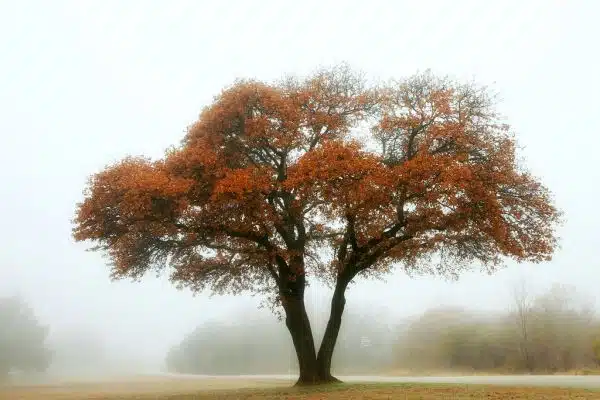Oak trees are a staple in the landscaping industry and have long been appreciated for their sturdy nature, providing shade during warmer months and a beautiful display of foliage in the fall. While many trees lose their leaves early on in the season, oak trees have a unique ability to hold onto their leaves well into late fall, making them an ideal addition to any landscape design. As arborists and tree care specialists, we understand the importance of incorporating various species of trees into our clients’ landscapes to provide maximum visual appeal year-round.
Late fall foliage can be just as stunning as the vibrant colors seen earlier in the season. Oak trees offer a warm, rustic aesthetic with their bronze and copper hues that add depth to any landscape design. The durability of oak leaves also makes them an excellent choice for those who wish to use natural materials for seasonal decorations such as wreaths or garlands. By utilizing oak trees for late fall foliage, homeowners can effectively extend the beauty of autumn throughout their property while also adding value to their investment through improved curb appeal.
The Benefits Of Using Oak Trees For Late Fall Foliage
Imagine you are walking down a street and notice the vibrant colors of leaves falling from a tree. You stop to admire the beauty of nature and realize that it’s an oak tree. Oak trees are one of the most popular species used for late fall foliage, and for good reason.
Oak trees have many benefits when it comes to their fall foliage. The color variations of oak leaves range from deep reds, oranges, and yellows, making them a popular choice for creating stunning autumn landscapes. Additionally, oak trees tend to hold onto their leaves longer than other tree species, allowing for a longer display of their vibrant colors.
As an arborist or tree care specialist, using oak trees for late fall foliage can greatly enhance the beauty of any landscape. With so many different oak tree species available, there is a wide range of color variations to choose from. Understanding the characteristics of each species can help in selecting the right one for your specific needs.
Understanding The Characteristics Of Oak Trees
The Benefits of Using Oak Trees for Late Fall Foliage are not limited to their stunning display of vibrant colors. Understanding the Characteristics of Oak Trees can help you determine which varieties will thrive in your landscape and enhance its aesthetic appeal. Oak tree varieties vary in size, shape, and growth patterns, so it’s essential to choose the right one for your specific needs.
Oak tree growth patterns can be classified as fast or slow-growing. Fast-growing oak trees are ideal for those who want a quick impact on their landscape. These varieties grow three feet or more per year and can reach maturity in less than 20 years. On the other hand, slow-growing oak trees are perfect for those who prefer a long-lasting investment. These types take 40-50 years to reach maturity but have an average lifespan of 200-300 years.
Another factor to consider when choosing an oak tree is its size and shape. Some oak trees have a pyramidal shape, while others grow into an oval or round canopy. It’s crucial to select an oak tree variety that fits well with your landscape design and doesn’t interfere with power lines or other structures.
Understanding the Characteristics of Oak Trees is vital when selecting the right type for your specific needs. The variety you choose should match your landscape design, growth rate preference, and space requirements. In the next section, we’ll discuss the steps involved in Choosing the Right Oak Tree for Your Landscape without compromising on quality or longevity.
Choosing The Right Oak Tree For Your Landscape
When it comes to selecting an oak tree for your landscape, there are some important choosing criteria to consider. Firstly, you want to determine the purpose of the tree – is it meant for shade, privacy or visual appeal? Secondly, you need to assess the site conditions such as soil moisture and pH levels, light exposure and available space. Another crucial factor is the mature size of the tree – make sure it fits the intended location without obstructing buildings or power lines.
Once you have narrowed down your options based on the above criteria, it’s time to think about tree placement. Oak trees are generally long-lived and slow-growing so it’s important to choose a permanent location that will allow them ample room to grow over time. Also keep in mind any potential conflicts with hardscapes like patios or sidewalks as well as other plants in close proximity.
Choosing a suitable oak tree for your garden can be a rewarding experience but requires careful consideration of several factors. By taking into account key criteria such as intended purpose, site conditions and mature size along with proper placement, you’ll ensure that your oak thrives in its environment and provides stunning fall foliage for years to come.
Transition: While choosing the right oak species is important for late fall foliage display, there are several other factors that affect how well an oak tree performs during this season.
Factors That Affect Oak Tree Foliage
Choosing the right oak tree for your landscape is a crucial decision that requires careful research and consideration. Once you have selected the perfect oak tree for your yard, it is important to understand the factors that affect its foliage. Factors such as climate, soil conditions, and pests can all impact the health of your oak tree’s leaves.
Climate plays a significant role in determining the color and timing of your oak tree’s fall foliage. Trees located in cooler climates will often display more vibrant colors than those in warmer areas. Additionally, trees exposed to prolonged periods of drought or extreme heat may lose their leaves early, resulting in less impressive autumn displays.
To preserve the beauty of your oak tree’s foliage, it is important to provide proper care and maintenance. Regular watering and fertilization can help keep your tree healthy and strong, allowing it to produce stunning fall colors year after year. Additionally, monitoring for pests and diseases can prevent damage to your tree’s leaves and ensure that they remain vibrant throughout the season.
In addition to climate and soil conditions, there are a variety of other factors that can impact the health of your oak tree’s foliage. By understanding these factors and taking steps to preserve your tree’s health, you can enjoy beautiful fall displays for years to come. In the next section, we will explore how climate and soil conditions can affect the health of your oak tree’s leaves in more detail.
Climate And Soil Conditions
Climate and soil compatibility are crucial factors in the growth and development of oak trees. Oak trees are hardy and adaptable to a wide range of climates, but they prefer moderate temperatures with plenty of sunshine, as well as well-draining soils. In general, oaks thrive in areas with hot summers and cool winters, such as the Mediterranean climate zone.
Growth rate analysis is an important tool for arborists and tree care specialists to use when selecting oak tree species for a particular climate or soil type. Some oak species grow faster than others, which can be advantageous in certain situations. For example, if you want to create a screen or windbreak, you may want to choose a faster-growing oak species like red oak. On the other hand, if you’re interested in creating a long-lived landmark tree, you may want to choose a slower-growing species like white oak.
In summary, understanding climate and soil conditions is essential for ensuring that your oak trees thrive. By analyzing growth rates and choosing appropriate species for your specific needs, you can cultivate healthy and beautiful trees that will provide beauty and enjoyment for years to come. In the next section, we will explore pruning and maintenance techniques that will help keep your oaks looking their best.
Pruning And Maintenance Techniques
Pruning is an important part of oak tree maintenance that shapes and controls the growth of trees. Fertilizing, mulching, and watering are all essential components of soil care to keep oak trees healthy. Pruning tools and techniques, such as trimming, pruning shapes, and pruning cuts, must be appropriate for controlling the growth of oak trees. Insect control, disease control, deadwood removal, crown thinning, and renewal pruning are all pruning techniques that should be considered when maintaining oak trees for late fall foliage.
Pruning
As an arborist, knowing the proper pruning techniques and timing strategies is crucial to maintain the health and beauty of oak trees. Pruning can help remove dead or diseased branches, improve air circulation, and promote new growth. However, improper pruning can cause irreparable damage to the tree.
One important technique for pruning oak trees is to avoid cutting during the growing season. Oak trees are susceptible to a fungal disease called oak wilt that can be spread through fresh cuts on the tree. As a result, it is best to prune oak trees during late fall or early winter when the tree is dormant. It is also important to use proper cutting tools and techniques to minimize damage and prevent further infection.
Timing strategies for pruning depend on the specific needs of each individual tree. For instance, if a tree has a broken branch or insect infestation, immediate pruning may be necessary to prevent further damage. On the other hand, if a tree simply needs shaping or thinning out, it may be best to wait until late fall when the leaves have fallen and the structure of the tree is more visible. By using appropriate pruning techniques and timing strategies, arborists can help ensure healthy and vibrant oak trees for years to come.
Fertilizing
Maintaining the health and beauty of oak trees requires more than just proper pruning techniques and timing strategies. Fertilizing is also an important aspect of tree care that arborists should consider. Fertilizers provide essential nutrients that trees need to grow healthy and strong. However, it is crucial to choose the right type of fertilizer and apply it correctly to avoid potential damage to the tree.
Organic fertilizers are a great option for those who prefer natural alternatives. These types of fertilizers are made from plant or animal matter, such as compost, bone meal, or blood meal. They release nutrients slowly over time, providing a steady supply of essential elements to the tree without overloading it with chemicals. Organic fertilizers also improve soil structure and promote beneficial microorganisms that aid in nutrient uptake.
Synthetic fertilizers are another option commonly used in tree care. These types of fertilizers contain concentrated amounts of nutrients that trees need, such as nitrogen, phosphorus, and potassium. However, they can be harmful if not applied properly or in excess amounts. Overuse of synthetic fertilizers can lead to nutrient imbalances or burn the tree’s roots. Arborists should carefully follow instructions on the label and use synthetic fertilizers sparingly to avoid any negative effects on the tree’s health.
In conclusion, choosing the right fertilizer is crucial for maintaining healthy oak trees. Arborists must consider various factors when selecting a fertilizer type, including soil conditions, nutrient deficiencies, and potential risks associated with each type of fertilizer. Whether organic or synthetic, applying fertilizer correctly can help ensure vibrant growth and longevity for these majestic trees.
Watering And Fertilization Considerations
Oak trees require adequate water to establish and maintain healthy growth. The irrigation needs of oak trees vary depending on the species, soil type, and climate conditions. It is important to provide consistent moisture to the root zone during periods of drought or extended dry weather. A well-designed irrigation system can help ensure that oak trees receive sufficient water without overwatering, which can lead to root rot or other fungal diseases.
In addition to proper watering, oak trees need a balanced supply of nutrients to thrive. Soil testing can help determine the nutrient requirements of your oak trees and guide fertilization practices. Commonly deficient nutrients in oak trees include nitrogen, phosphorus, potassium, and iron. However, excessive fertilizer application should be avoided as it can lead to nutrient imbalances or damage to tree roots. Arborists recommend using slow-release fertilizers applied at the appropriate time for optimal uptake.
In summary, proper irrigation and fertilization are essential for maintaining healthy oak trees. Regular monitoring of soil moisture levels and nutrient status is necessary to adjust management practices accordingly. By providing adequate water and nutrients, you can promote strong root development and vigorous growth in your oak trees. In the next section, we will discuss how to protect your oaks from pests and diseases by implementing preventative measures.
Protecting Your Oak Trees From Pests And Diseases
Proper watering and fertilization are essential for the health of oak trees, especially during the growing season. However, as fall approaches, gardeners and landscapers often shift their focus to the aesthetic appeal of their landscapes. Oak trees are known for their striking foliage in late fall, and incorporating them into your landscape design can add a beautiful touch.
To ensure that your oak trees provide stunning fall foliage, preventive measures should be taken throughout the year. Regular pruning can promote healthy growth and prevent pests and diseases from taking hold. Additionally, keeping the tree well-watered during dry spells can prevent stress that could lead to leaf drop or color loss. Natural remedies such as neem oil or insecticidal soap can also be used to deter pests like aphids or spider mites.
When it comes to incorporating oak trees into your landscape design, there are several factors to consider. First, choose an appropriate location with plenty of space for the tree to grow without encroaching on nearby structures or plants. Additionally, consider the soil type and pH level in the chosen location to ensure that it is suitable for oak tree growth. Finally, think about how the tree will fit into your overall design scheme – will it provide shade for other plants or serve as a focal point in a specific area?
Incorporating oak trees into your landscape design requires careful planning and attention to detail but can result in a beautiful addition to any outdoor space. By taking preventive measures throughout the year and considering factors such as location and soil type when planting, you can enjoy stunning late-fall foliage from these majestic trees for years to come.
Incorporating Oak Trees Into Your Landscape Design
Oak trees are a popular choice for landscaping due to their long lifespan and beautiful foliage. Landscape integration of oak trees can be achieved by planting them in areas where they can grow to their full potential without interference from structures or other plants. Design tips for incorporating oak trees into your landscape include selecting the right species for your climate, providing adequate space for growth, and considering the impact of tree placement on surrounding plants and structures.
When selecting an oak species for your landscape design, it is important to consider your climate zone. Certain species thrive in specific climates, while others may not survive harsh winters or hot summers. Consulting with a local arborist or nursery specialist can help you choose the best species for your area. Once you have selected a species, ensure that you provide enough space for the tree to grow to its full size without crowding other plants or structures.
Placement of oak trees in your landscape design should also take into account their impact on surrounding plants and structures. For example, large oaks may shade out smaller plants if planted too close together, while their roots may damage nearby sidewalks or foundations if not given adequate space. Careful planning and consultation with a tree care specialist can help prevent such issues and ensure that your oak trees enhance rather than detract from your overall landscape design.
Incorporating oak trees into your landscape design requires careful consideration of species selection, spacing, and placement. With proper planning and consultation with experts in arboriculture and landscaping, you can create a beautiful and sustainable outdoor space that will provide enjoyment for years to come.
As we have discussed above how incorporating oak trees into your landscape design can add beauty to it, now let us move towards using oak leaves for seasonal decorations.
Using Oak Leaves For Seasonal Decorations
Preserving oak leaves for seasonal decorations requires careful preparation to maintain the leaves’ vibrant colors. Oak leaves can be preserved by a process of pressing and drying them. Creative decorating ideas can be employed using preserved oak leaves, such as creating wreaths, table ornaments, or wall art. Oak leaves also can be used in crafts like making wreaths, banners, or even dried bouquets.
Preserving Oak Leaves
The beauty of oak leaves during the fall season is a sight to behold. Their natural hues of burnt orange, golden yellows, and deep reds are a perfect addition to any seasonal decoration. Preserving oak leaves for DIY crafts and home decor is not only an eco-friendly way to repurpose nature’s gifts but also a cost-effective way to enhance the ambiance of any space.
Storing techniques for preserved oak leaves are crucial in maintaining their quality and color. It is best to store them in a cool, dry place with low humidity levels. Avoid exposing them to direct sunlight or moisture as this can cause discoloration or mold growth. One of the most practical ways to preserve oak leaves is by pressing them between sheets of paper and placing them in a heavy book for several weeks until they are completely dry.
DIY crafts using preserved oak leaves can be endless. From wreaths to table centerpieces, there are no limits when it comes to incorporating these beautiful natural elements into your home decor. Crafting enthusiasts can use preserved oak leaves as stencils, decoupage materials, or even create intricate designs for wall art pieces. The possibilities are endless, and with proper storage techniques, you can enjoy their vibrant colors for years to come.
In conclusion, preserving oak leaves is an excellent way to extend the life of their stunning autumnal colors while adding warmth and charm to your home decor. By following proper storing techniques, you can ensure that they maintain their vibrancy and beauty throughout the year. With a little creativity and imagination, DIY crafts using preserved oak leaves can transform any living space into an inviting haven that exudes nature’s elegance.
Creative Decorating Ideas
As arborists, we understand the beauty and significance of oak trees in our environment. Apart from their ecological contribution, oak leaves can be used for seasonal decorations, providing a rustic and natural touch to any space. With proper preservation techniques and creative ideas, oak tree crafts can add warmth and charm to your home decor.
One of the most popular ways of using preserved oak leaves is by creating DIY oak leaf wreaths. These wreaths are easy to make, cost-effective, and perfect for welcoming guests during autumn or Thanksgiving gatherings. By using a wire frame as a base and attaching preserved oak leaves with hot glue or floral wire, you can create a beautiful wreath that will last for years to come.
In addition to DIY oak leaf wreaths, there are numerous other creative decorating ideas that incorporate preserved oak leaves. You may use them as stencils for painting on wood or fabric materials or even frame them as wall art pieces. Preserved oak leaves also work well as table centerpieces when combined with other fall elements such as acorns, pumpkins, or candles. With endless possibilities for creativity and decoration, preserving oak leaves is not only eco-friendly but also an enjoyable way to bring nature’s elegance into your living space.
Creating A Rustic Aesthetic With Oak Trees
Oak trees are a popular choice for enhancing the rustic decor of a property, especially during the autumn landscape. With their broad canopies and rich foliage, these trees add a touch of natural charm that is hard to replicate with any other species. They can also create an inviting atmosphere that welcomes visitors and adds warmth to any space.
To create a rustic aesthetic using oak trees, several factors must be taken into consideration. First, it is essential to choose the right location for planting the tree. Oak trees thrive in well-drained soil and require ample sunlight to grow properly. Additionally, pruning and shaping the tree can help give it a more refined look that complements its surroundings.
Here are four ways oak trees can be incorporated into a rustic decor:
- Use an oak tree as a focal point in your landscape design.
- Place garden benches or seating areas underneath them.
- Create charming pathways around the base of the trunk.
- Add outdoor lighting fixtures to highlight the tree’s beauty at night.
By following these tips, you can create an inviting atmosphere that will make your property stand out from others in your neighborhood.
Transition: Now that we have discussed how oak trees can enhance the rustic aesthetic of a property let’s explore how they can also improve curb appeal.
Enhancing Curb Appeal With Oak Trees
Pruning oak trees is important for overall health and appearance of the trees, and should be done regularly to promote new growth and maintain the desired shape of the tree. When selecting oak trees for fall foliage, consider the type of oak as well as the climate in which it will be planted. Planting oak trees is best done in late winter or early spring when the weather is cooler and the soil is more moist. To ensure successful planting, dig a hole twice as wide as the root ball of the tree and provide adequate space for growth. After planting, oak trees should be watered regularly, especially during the summer to promote healthy growth. Fertilizing oak trees can also help to promote growth and improve the amount of fall foliage produced.
Pruning Oak Trees
Pruning oak trees is essential to maintain their health and appearance. Pruning techniques vary depending on the desired outcome, such as removing dead or diseased branches, shaping the tree, or increasing sun exposure to the lower branches. It is important to use proper pruning tools and techniques to avoid damaging the tree.
Timing considerations are crucial when pruning oak trees. Winter is an ideal time for major pruning as the tree is dormant and less susceptible to damage. However, minor pruning can be done year-round as needed. Avoid pruning in late spring and early summer when oak wilt disease is most prevalent. It is also important to consider the age of the tree and its growth rate when determining how much to prune at one time.
In conclusion, proper pruning techniques and timing considerations are key factors for maintaining healthy and beautiful oak trees. A well-pruned oak tree not only enhances curb appeal but also contributes to a safer environment by removing hazardous branches. As arborists or tree care specialists, it is our responsibility to provide expert advice and services that benefit both our clients and the environment.
Selecting Trees For Fall Foliage
As arborists or tree care specialists, we understand the importance of enhancing curb appeal with oak trees. One way to achieve this is by selecting the right species for their fall foliage display. Choosing the right species can add a burst of color and texture to any landscape, making it more inviting and visually appealing to passersby. However, it is crucial to consider factors such as climate, soil type, and available space when selecting trees for fall foliage.
When choosing trees for fall foliage, it is essential to consider their growth habits and planting requirements. Some species may require specific soil conditions or light exposure to thrive, while others may grow too large for the available space over time. It is also important to follow best planting practices such as proper spacing and mulching to ensure healthy growth and development. By selecting the right species and following best planting practices, we can help our clients achieve optimal results in enhancing curb appeal with oak trees.
In conclusion, selecting trees for fall foliage can greatly enhance curb appeal while adding value to any landscape. As arborists or tree care specialists, it is our responsibility to provide expert advice on choosing the right species and implementing best planting practices for optimal growth and performance. By doing so, we can contribute to creating beautiful outdoor spaces that serve both our clients’ needs and the environment’s well-being.
Planting Oak Trees
As arborists or tree care specialists, we understand the benefits of oak trees in enhancing curb appeal. Aside from their beautiful fall foliage display, oak trees also provide shade and shelter to wildlife, reduce noise pollution, and improve air quality. However, planting oak trees requires careful consideration of planting techniques to ensure their healthy growth and longevity.
Planting oak trees should begin with site selection. It is important to choose a location that can accommodate the mature size of the tree and provides adequate sunlight and soil conditions. Proper spacing between trees is also crucial to prevent overcrowding, competition for resources, and potential hazards such as falling branches. In addition, mulching around the base of the tree can help retain moisture and suppress weed growth while improving soil health.
Once the site is selected, proper planting techniques should be followed to ensure optimal growth and performance. These include digging a hole that is deep enough to accommodate the root ball but not too deep that it covers the trunk flare; loosening compacted soil around the hole to facilitate root penetration; backfilling with native soil mixed with organic matter; and watering thoroughly after planting. By implementing these best practices, we can help our clients achieve successful establishment of oak trees that enhance curb appeal while providing long-term benefits for both humans and nature alike.
Oak Trees And Property Value
Did you know that planting an oak tree on your property can increase its value by up to 10%? It’s true! Oak trees are highly sought after by homeowners for their aesthetic appeal and numerous benefits. In fact, a study conducted by the University of Georgia found that homes with mature trees, such as oaks, sold for 5-15% more than homes without trees.
The benefits of oak trees go far beyond aesthetics. They provide shade, reduce air pollution, and act as natural water filters. Additionally, oak trees have been shown to improve mental health and well-being, with studies linking exposure to nature with reduced stress levels and improved cognitive function. All of these benefits contribute to the overall value of a property.
When it comes to maximizing the benefits of oak trees for property value, it’s important to consider their care and maintenance. This includes regular pruning to ensure optimal growth and health, as well as proper fertilization and watering techniques. By investing in the care of your oak tree, you can enjoy all of its benefits while also increasing the value of your property.
| Oak Tree Benefits | Property Value |
|---|---|
| Aesthetic Appeal | 5-15% Increase |
| Shade | |
| Air Pollution Reduction | |
| Water Filtration |
Looking for tips on how to successfully care for your oak tree? Keep reading for expert advice on pruning techniques, fertilization schedules, and more!
Tips For Successful Oak Tree Care
Watering an oak tree should be done regularly and deeply, allowing the soil to become moist but not soggy. Fertilizing should be done in the spring and fall, using a slow-release fertilizer specifically made for oak trees. Pruning should be done to remove dead or diseased branches, as well as to maintain a desired shape. Mulching should be done to a depth of several inches, using an organic mulch that is free of weed seeds.
Watering
Maintaining the health of oak trees is essential for achieving optimal late fall foliage. As an arborist, I have observed that watering is one of the most crucial aspects of tree care. Deep watering encourages deep root growth, which is essential for the overall health and longevity of oak trees.
The frequency of watering depends on various factors such as soil type, weather conditions, and tree age. Younger trees require more frequent watering than mature ones. During dry seasons or droughts, it is recommended to water oak trees once every week to ensure that they receive enough moisture to thrive.
In conclusion, deep watering and proper frequency are critical in maintaining healthy oak trees for late fall foliage. As a tree care specialist, I highly recommend monitoring your tree’s water requirements regularly to ensure they receive adequate amounts of moisture for their optimal growth and beauty.
Fertilizing
After discussing the importance of watering oak trees, another critical aspect of oak tree care is fertilization. Fertilizing helps maintain the necessary nutrients that are essential for growth and development. However, before adding any fertilizer, it is crucial to conduct a soil test to determine which nutrients are missing or in excess. The results of the soil test will guide you on which organic fertilizer options to use.
Organic fertilizers such as compost, manure, and worm castings are excellent choices for oak trees as they slowly release nutrients into the soil without causing harm to the environment. It is vital to apply the fertilizer at least once a year during early spring when the tree starts growing new leaves. Avoid applying too much fertilizer as this can lead to excessive growth that may be harmful to the tree’s overall health.
In conclusion, maintaining healthy oak trees requires more than just watering; it also involves fertilization. Soil testing should be conducted before selecting any organic fertilizer options that will provide essential nutrients required by the oak tree. As an arborist or tree care specialist, I highly recommend following proper fertilization techniques for optimal growth and beauty of your oak trees.
Conclusion: Embracing The Beauty Of Late Fall Foliage With Oak Trees
Oak trees are a valuable addition to any landscape, particularly in late fall when they display their vibrant foliage. As the leaves begin to change color and eventually fall, oak trees add a warm and inviting feel to any environment. However, this beauty comes at a cost as these trees require proper care and preservation techniques to remain healthy.
Oak tree symbolism is rooted in strength, endurance, and longevity. These traits are reflected in the tree’s ability to withstand harsh weather conditions and maintain its beauty throughout the seasons. To ensure that this resilience is maintained, it is essential to provide adequate care for oak trees. This includes regular pruning and watering as well as protecting them from pests and diseases.
Oak tree preservation is vital for maintaining their beauty for generations to come. In addition to providing aesthetic value, oak trees also offer several environmental benefits such as improving air quality, reducing erosion, and providing shelter for wildlife. By prioritizing preservation efforts such as planting new oak trees, protecting existing ones from damage or removal, and educating others about their importance, we can ensure that our communities continue to enjoy the many benefits of these magnificent trees.
- Regular pruning
- Adequate watering
- Protection from pests and diseases
- Preservation efforts such as planting new oak trees
As we embrace the beauty of late fall foliage with oak trees, let us also remember the importance of proper care and preservation techniques. By doing so, we can continue to enjoy the many benefits of these majestic symbols of strength and longevity for years to come.
Conclusion
Using oak trees for late fall foliage provides numerous benefits for homeowners and property managers. Oak trees, with their vibrant colors and sturdy structure, offer a stunning display of autumnal beauty. Understanding the characteristics of oak trees and choosing the right specimens for your landscape can greatly enhance curb appeal and increase property value.
When selecting an oak tree for your yard, it is important to consider factors such as climate, soil conditions, and desired aesthetics. Different varieties of oak trees have distinct foliage characteristics that can affect their color and vibrancy during late fall. Proper care and maintenance are also critical to ensuring the health and longevity of your oak trees.
As arborists or tree care specialists, we recommend embracing the beauty of late fall foliage with oak trees. Not only do they provide aesthetic appeal, but they also offer environmental benefits such as shade, air purification, and carbon sequestration. By selecting the right oak tree species for your landscape and providing proper care, you can enjoy their stunning colors year after year while also contributing to a healthier planet. So why not consider incorporating an oak tree into your landscape this fall?
Image Credits
- “Oak Tree in the Fog” by TexasEagle (featured)





























